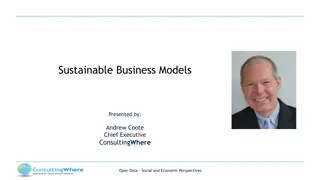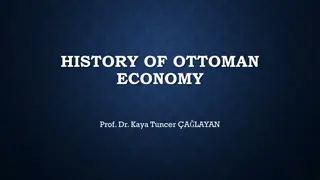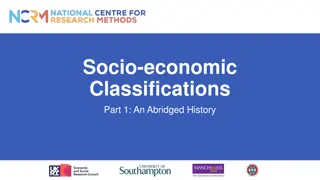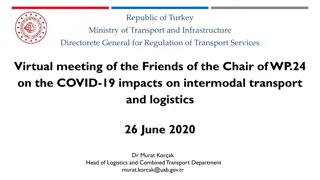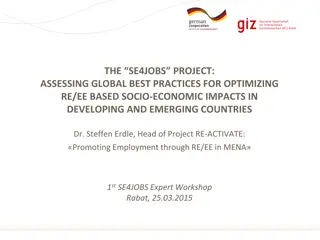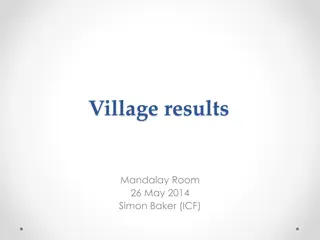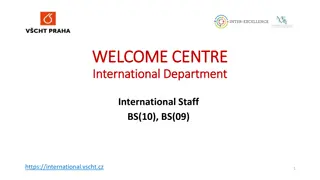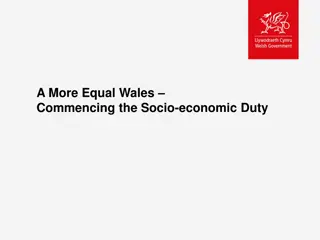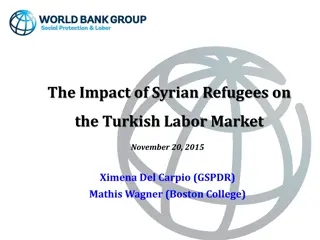Socio-Economic Impact Assessment of Syrians under Temporary Protection on Turkish Hosting Communities
This study, conducted in Turkey, aims to assess the socio-economic impact of Syrians under Temporary Protection (SuTPs) on Turkish hosting communities. Through a mix of quantitative and qualitative research methods, the study focuses on identifying the impacts on host communities, utilizing a sample size of 3700 households across various geographic domains. Topics covered in the research include household conditions, income vs. expenses, welfare standards, municipal services, and more.
Download Presentation

Please find below an Image/Link to download the presentation.
The content on the website is provided AS IS for your information and personal use only. It may not be sold, licensed, or shared on other websites without obtaining consent from the author.If you encounter any issues during the download, it is possible that the publisher has removed the file from their server.
You are allowed to download the files provided on this website for personal or commercial use, subject to the condition that they are used lawfully. All files are the property of their respective owners.
The content on the website is provided AS IS for your information and personal use only. It may not be sold, licensed, or shared on other websites without obtaining consent from the author.
E N D
Presentation Transcript
Socio-economic Assessment of the Impact of Syrians under Temporary Protection (SuTPs) on Turkish Hosting Communities Presented by: Anna Gueorguieva Joint work by the Turkey Social, Urban, Rural and Resilience (SURR), Social Protection and Labor (SPL) and Poverty teams Key contacts: Joanna De Berry, William Wiseman and Holly Benner
Objectives of the study Identify the socio-economic impacts on host communities
Research Design Quantitative assessment - a nationally representative household survey with SuTP and local Turkish households. Qualitative assessment Perceptions, experiences, priorities of the informants Trends identified through the quantitative work. (i) focus groups (ii) semi-structured and open-ended interviews 3
Case study Country: Turkey Both camp and out of camp Focus on urban but both settings
Sampling methodology Sample size: 3700 households Dwelling sample of both SuTPs and non-SuTPs Stratified cluster sample with 4 geographic domains 1. Istanbul, with a focus on the areas with high numbers of SuTPs 2. Areas with high densities of SuTPs, particularly in the southeast of the country 3. Areas with low predicted numbers of SuTPs 4. Remaining areas of the country Oversamples SuTPs and non-SuTPs living in areas with a high SuTP density SuTPs living in Camps Clustered design in which camps are primary sampling units Based on camp lists complied by AFAD 5
Questionnaire Welfare Municipal Services Labor Market & skills Syrians and Host Communities Other Education 6
QUANTITATIVE SURVEY TOPICS Provides basic information about all household members and describes their relationships. Household Roster Household conditions housing type, size, and quality Household assets (e.g. TV, internet access, refrigerator, cell phone) Household income vs. expenses e.g. salary, pensions, social assistance, rental income vs. housing, food, services, education, transport expenses Welfare Standard of housing Rental and sale prices for housing Utilities, power and water -- quality, access and cost Sanitation facilities and services -- quality, access and cost Public transportation and roads -- quality, access and cost Distance to key services e.g. hospitals, doctors, schools Comparison of the above to one year ago and four years ago Future plans for household moves and rationale Municipal Services 7
QUANTITATIVE SURVEY TOPICS Employment and jobs of household members Type of employment (e.g. formal/informal; full time/part-time) Number of hours worked per week Compensation received/salary levels Type of workplace Job content (e.g. skilled/unskilled) Aspirations for employment (work hours, responsibilities, workplace) Experiences with unemployment and job searching Employment situation compared to one year ago and four years ago Labor For each member in the household: Level of schooling achieved Attendance rates Cost of education-related expenses Type of curriculum Language of instruction Ease/quality of transport to school Perceptions of learning experience of child Degree to which Turkish/SuTPs joint attendance in school Perceptions of improvements/challenges in education services compared to one year ago and four years ago Education 8
QUANTITATIVE SURVEY TOPICS Frequency of social contact within and outside of nationality/ethnic group Type of support received from nationality/ethnic group Level of connection to communities in Syria Levels of trust within Turkish communities Networks Satisfaction income/employment, education, security, justice, municipal services Satisfaction levels with overall quality of life Satisfaction levels compared to one year ago and four years ago levels on issues such as food, housing, health, Quality of Life 9
TIME AND COST INVOLVED Field implementation commencing January 2016 Expect Cost $600,000 for both quantitative and qualitative work
QUALITATIVE METHODS Target groups: Syrian and Turkish families Same sample as quantitative work Sub-sets of special interest groups --women, children, youth, community leaders Service providers to SuTPs -- teachers, municipal authorities, Social Solidarity Foundations, employers and shop keepers
QUALITATIVE SURVEY TOPICS Services Labor market Household stresses Positive and negative impact of SuTP Interactions with SuTP Priority areas where policy and services need to change Turkish Families Additional questions: Household decision making dynamics and coping resources Syrian Families Labor market Preferences and demand for SuTP/Turkish employees Trends in job creation over time Employers 12
QUALITATIVE SURVEY TOPICS Frequency of social contact within and outside of nationality/ethnic group Type of support received from nationality/ethnic group Level of connection to communities in Syria Levels of trust within Turkish communities Teachers/School administrators Satisfaction levels on issues such as food, housing, health, income/employment, education, security, justice, municipal services Satisfaction levels with overall quality of life Satisfaction levels compared to one year ago and four years ago Municipal Authorities Services over time Applicants and needs Household stresses over time Priority areas where policy, services or resource allocation needs to change Social Solidarity Foundations 13
KEY IMPLEMENTATION ISSUES Access to the camps via AFAD Finalization of sampling strategy with DGMM Finalization of quantitative survey modules with line ministries Choice of implementing university/research institution 14
THANK YOU! Key corresponding contacts: Joanna De Berry jdeberry@worldbank.org William Wiseman wwiseman@worldbank.org Holly Benner hbenner@worldbank.org 15
ANNEXES 16
KEY POLICY DECISIONS AND NEXT STEPS 1. Employment Whether permits should be granted to SuTP and how this can be done with positive consequences for Turkish workers Improved quantification of skills amongst SuTP workers to understand what they bring to the Turkish labor market What employment and training services will SuTPs need to integrate into the Turkish labor market? Improved quantification of current impact of SuTP workers on the Turkish labor force Improved analysis of the potential impact of work permits for the Turkish labor force and necessary mitigation measures 2. Education Whether to keep three systems in place for education of SuTP children (integration into Turkish schools, Temporary Education Centers, Community-Based Education) or to prioritize one over the others And how to respond to SuTP preference on this issue and aspirations for their children How to support Turkish schools to take in more SuTP children without compromising the quality of education Need to understand the main barriers for accessing schools for SuTP and how to address them How to strengthen mechanisms such as Turkish language classes that facilitate SuTP children s entry into the Turkish education system. How to respond to the psycho-social challenges of SuTP children, which affect their learning Improve data on skills, capacity and training demands by Syrian teachers leading to increased regularization of their work and support. 17
KEY POLICY DECISIONS AND NEXT STEPS 3. Municipal Services Need to fully understand the demand placed on municipalities by SuTP and level of access among SuTP to municipal services including what constrains that access Need to understand how increased SuTP is affecting municipal services for Turkish hosting communities Decide whether and how to give municipalities more financing to extend their services in line with the population increases caused by SuTP How to improve coordination between municipalities and NGOs delivering services to SuTP 4. Housing Need to quantify the housing conditions of SuTP, especially the numbers and vulnerabilities associated with living in poor and exploitative conditions. Need to quantify the quantify the impact of SuTP housing and utility demand on Turkish communities and devise mitigation measures including looking at affordability Decide whether to start a new (but still non-camp) response to SuTP housing needs such as housing vochures and increased social housing 18


